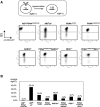A role for PCNA ubiquitination in immunoglobulin hypermutation
- PMID: 17105346
- PMCID: PMC1618868
- DOI: 10.1371/journal.pbio.0040366
A role for PCNA ubiquitination in immunoglobulin hypermutation
Abstract
Proliferating cell nuclear antigen (PCNA) is a DNA polymerase cofactor and regulator of replication-linked functions. Upon DNA damage, yeast and vertebrate PCNA is modified at the conserved lysine K164 by ubiquitin, which mediates error-prone replication across lesions via translesion polymerases. We investigated the role of PCNA ubiquitination in variants of the DT40 B cell line that are mutant in K164 of PCNA or in Rad18, which is involved in PCNA ubiquitination. Remarkably, the PCNA(K164R) mutation not only renders cells sensitive to DNA-damaging agents, but also strongly reduces activation induced deaminase-dependent single-nucleotide substitutions in the immunoglobulin light-chain locus. This is the first evidence, to our knowledge, that vertebrates exploit the PCNA-ubiquitin pathway for immunoglobulin hypermutation, most likely through the recruitment of error-prone DNA polymerases.
Conflict of interest statement
Competing interests. The authors have declared that no competing interests exist.
Figures






Comment in
-
Borrowing a DNA repair enzyme to fine-tune antibody specificity.PLoS Biol. 2006 Nov;4(11):e403. doi: 10.1371/journal.pbio.0040403. Epub 2006 Oct 24. PLoS Biol. 2006. PMID: 20076498 Free PMC article. No abstract available.
References
-
- Hoege C, Pfander B, Moldovan GL, Pyrowolakis G, Jentsch S. RAD6-dependent DNA repair is linked to modification of PCNA by ubiquitin and SUMO. Nature. 2002;419:135–141. - PubMed
-
- Stelter P, Ulrich HD. Control of spontaneous and damage-induced mutagenesis by SUMO and ubiquitin conjugation. Nature. 2003;425:188–191. - PubMed
-
- Kannouche PL, Wing J, Lehmann AR. Interaction of human DNA polymerase eta with monoubiquitinated PCNA: A possible mechanism for the polymerase switch in response to DNA damage. Mol Cell. 2004;14:491–500. - PubMed
Publication types
MeSH terms
Substances
Associated data
- Actions
- Actions
- Actions
- Actions
- Actions
LinkOut - more resources
Full Text Sources
Other Literature Sources
Molecular Biology Databases
Research Materials
Miscellaneous

